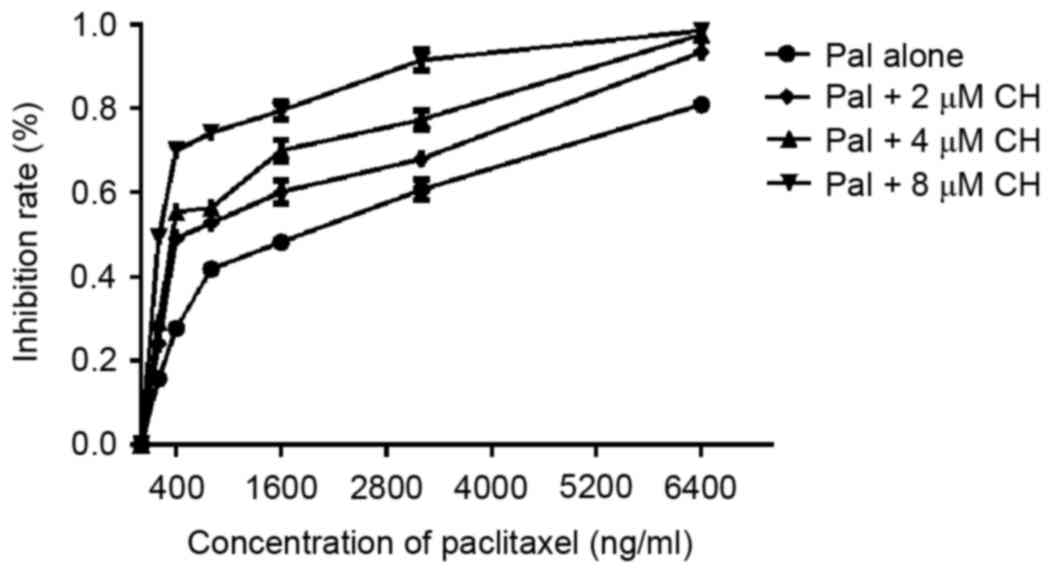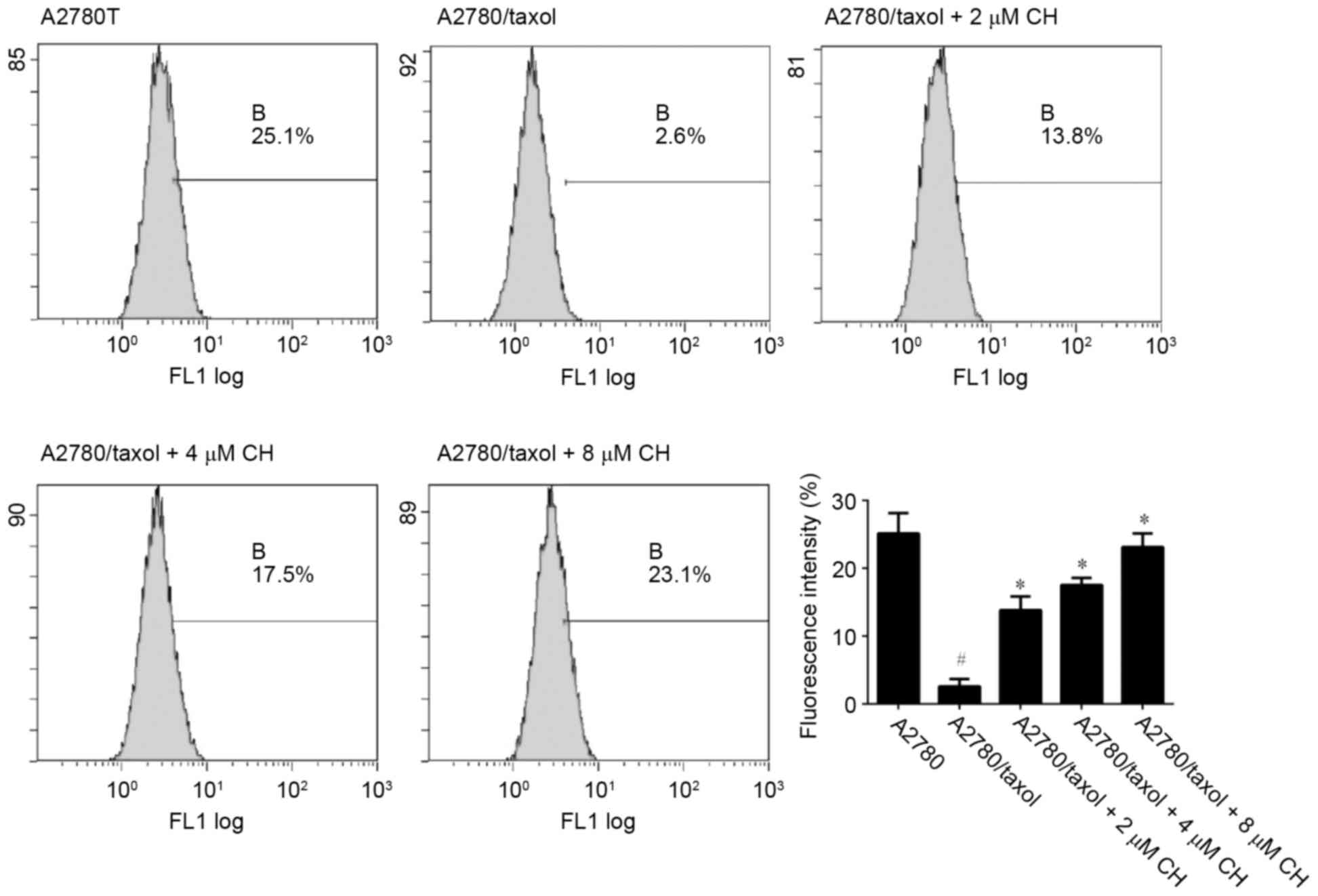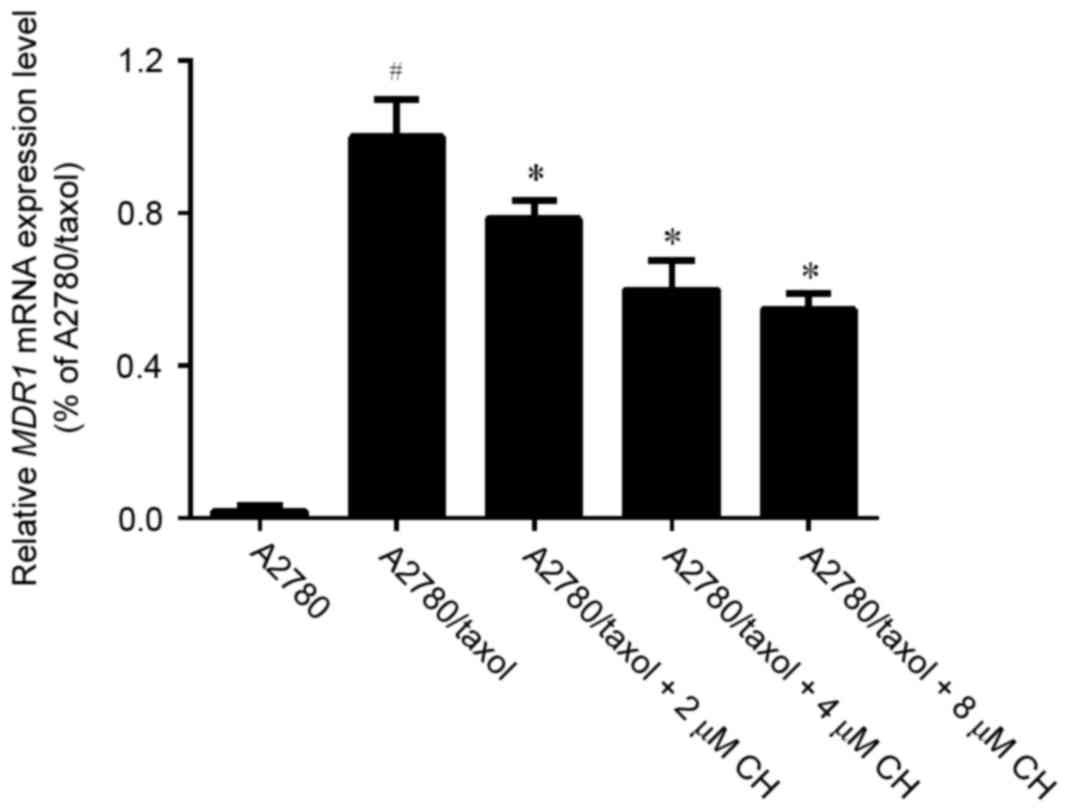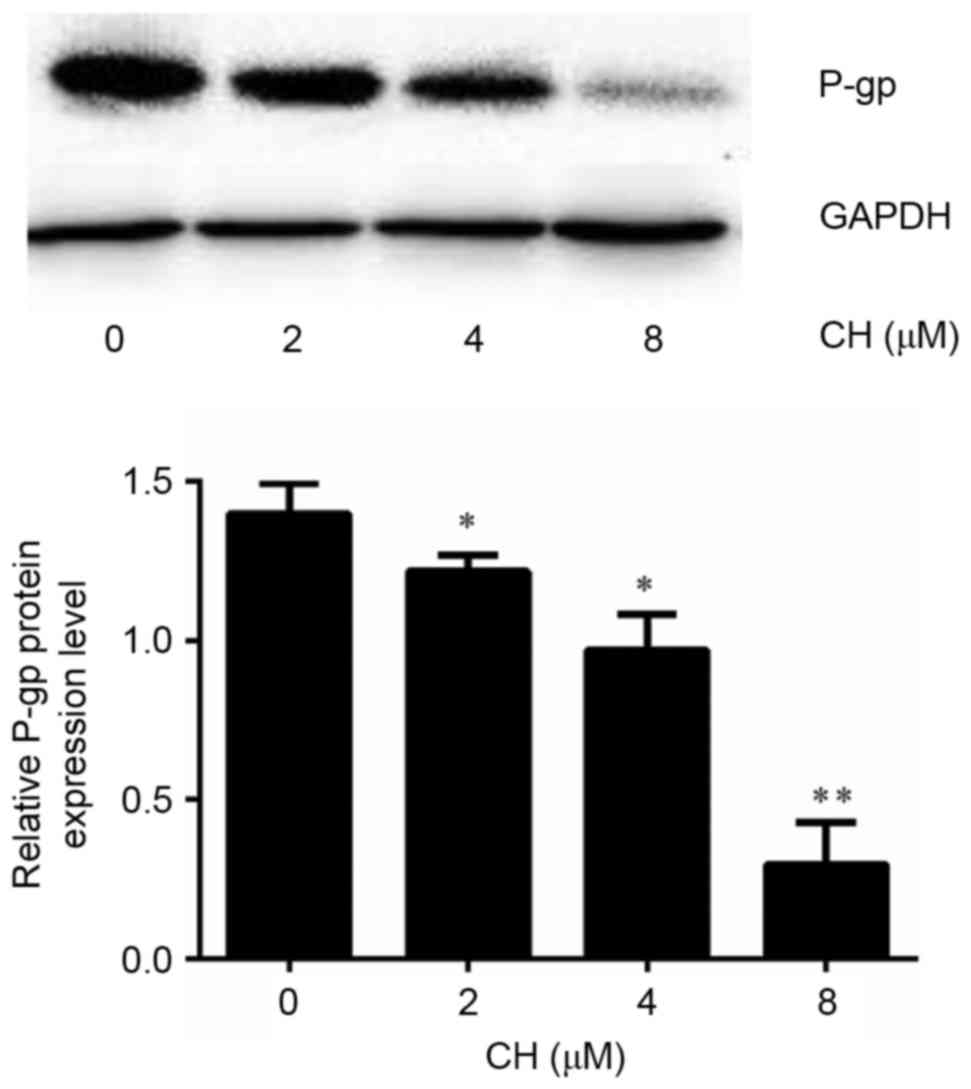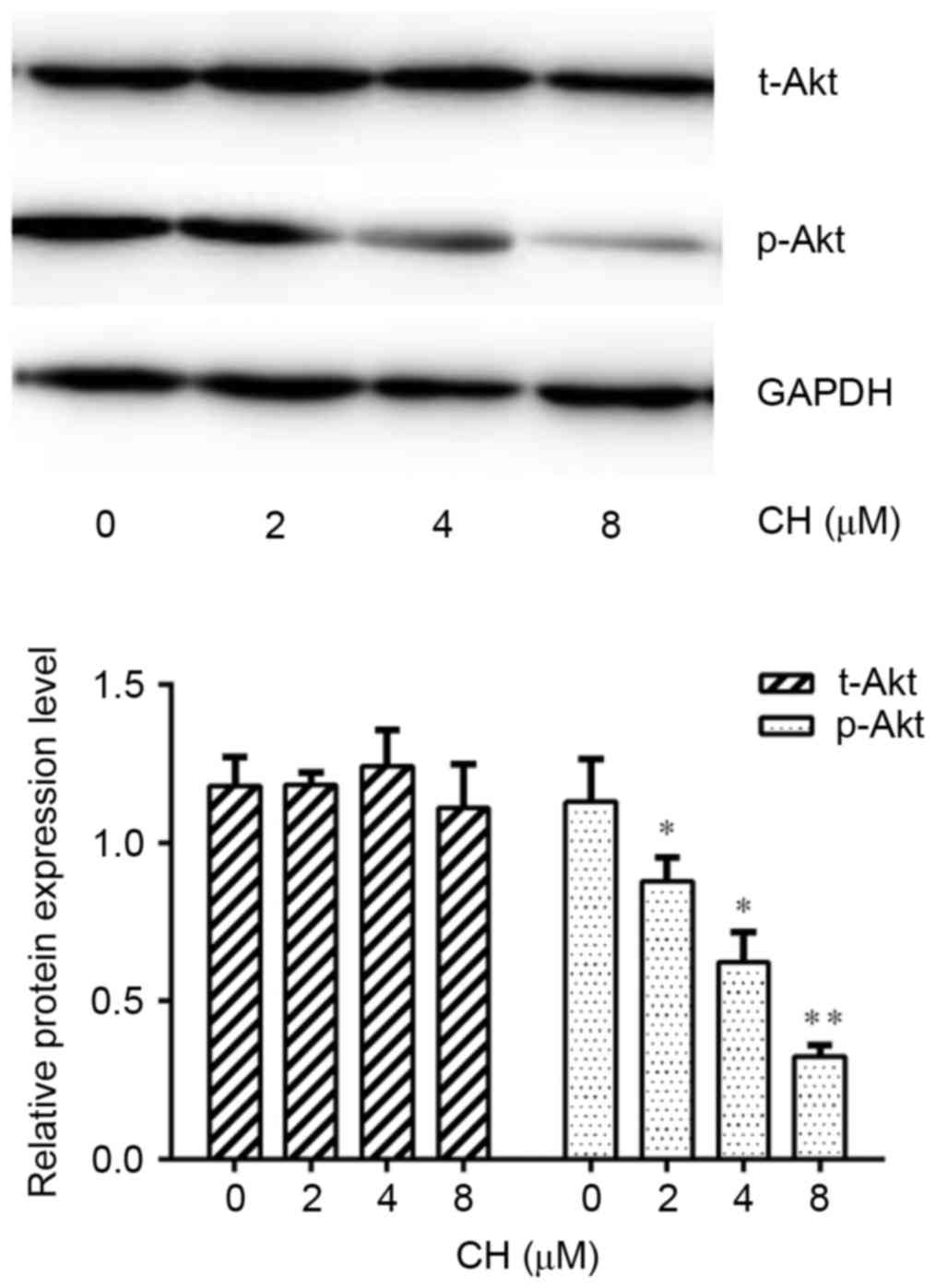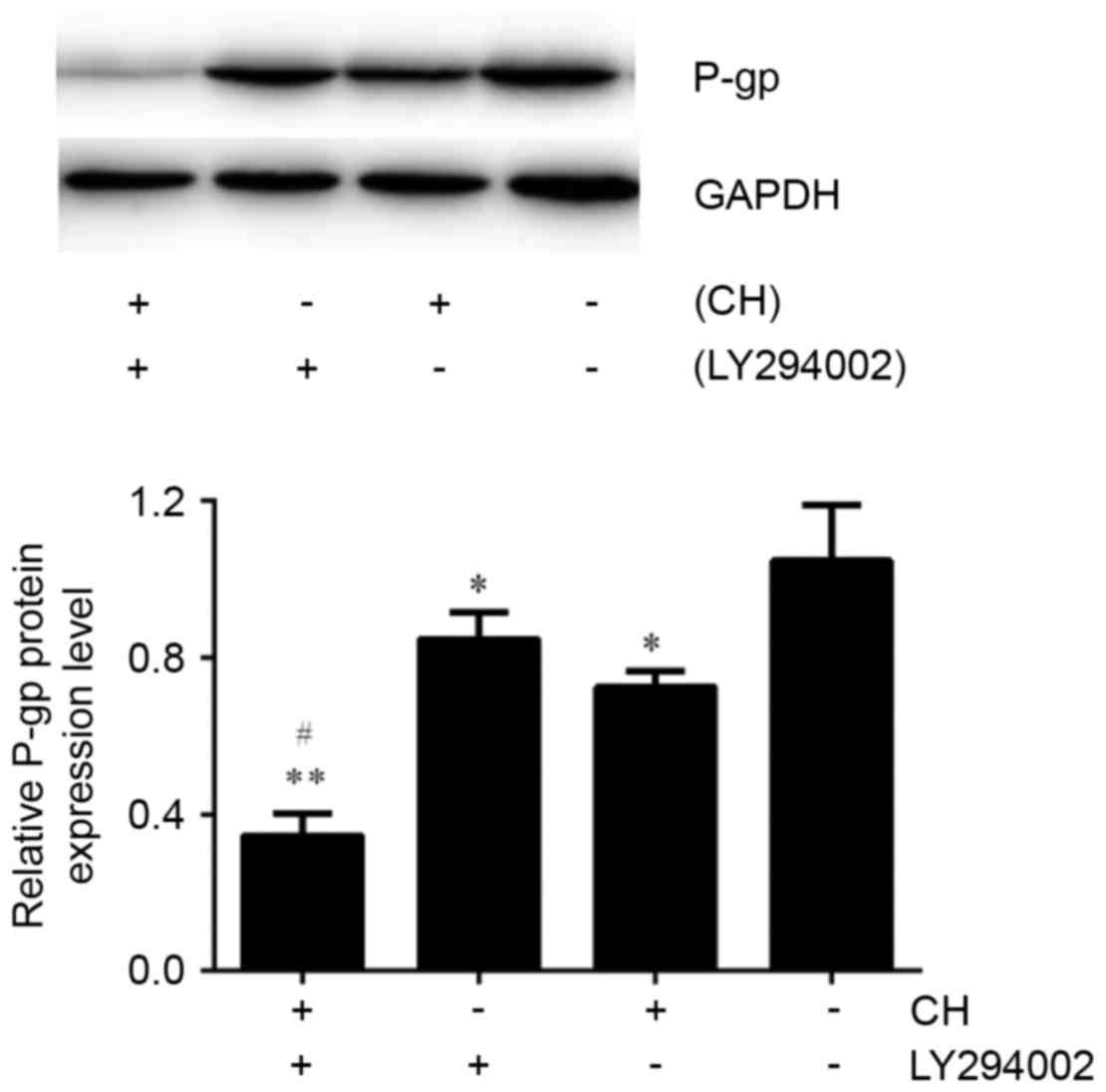Introduction
Ovarian cancer has the highest mortality rate among
gynecologic malignant tumors and is the fifth leading cause of
cancer death in women worldwide (1). Patients with ovarian cancer are
treated with standard therapy, including debulking surgery and
platinum and taxane-based chemotherapy, but have a low 5-year
relative survival rate of <45%, according to the latest
statistics (2). The major obstacle
to treatment success is the development of multidrug resistance
(MDR) (3).
MDR occurs when malignant tumors become resistant to
one type of anticancer drug and acquire simultaneous resistance to
different drugs with different chemical structures and modes of
action. The most common mechanism of MDR is the overexpression of
ATP-binding cassette (ABC) transporters, a protein family of efflux
pumps on cell membranes. These transporters have a drug-binding
site that is able to change conformation to recognize and catalyze
the efflux of diverse substrates from cells (4,5). Among
them, P-glycoprotein (P-gp), encoded by the MDR1 gene,
extrudes chemotherapeutic drugs out of cancer cells and plays an
important role in the drug resistance of human cancers.
MDR1/P-gp expression, which has been studied
in numerous malignant cells, including human ovarian tumors
(6,7), is mediated through various pathways,
including the extracellular signal-regulated kinase (ERK) (8), c-Jun NH2-terminal kinase (JNK)
(9), nuclear factor
κ-light-chain-enhancer of activated B cells (NF-κB) (10), and phosphoinositide 3-kinase
(PI3K)/Akt pathways (11). Among
these, PI3K/Akt, a well-studied signal transduction pathway related
to apoptosis, was recently reported to be involved in reversing
solid tumor MDR (12).
Consequently, the PI3K/Akt signaling pathway could become a new
therapeutic target for reversing drug resistance in ovarian
cancer.
Because they are more potent and less toxic than
previous MDR reversal agents, natural extracts have been evaluated
for the discovery of novel MDR reversing agents (13). We evaluated cepharanthine
hydrochloride (CH), a natural alkaloid-derived reversal agent
produced by salification from cepharanthine. Cepharanthine,
extracted from Stephania cepharantha Hayata (14), was reported to reverse MDR primarily
through the suppression of P-gp function and expression in certain
MDR tumor cells (15,16). This result was similar to that of
our previous study on leukemia (9,17,18).
However, to the best of our knowledge, there is no data concerning
the ability of CH to reverse MDR in an ovarian cancer cell line or
the evaluation of its regulatory mechanism. In the present study,
we assessed whether CH improved tumor sensitivity to
chemotherapeutics in ovarian malignancy following our preview study
regarding signaling pathways (9).
In addition, we sequentially explored the regulation of the
relevant signal transduction.
Materials and methods
Cell lines and cell culture
The human ovarian cancer cell line, A2780
(paclitaxel-sensitive), and its paclitaxel-resistant counterpart,
A2780/Taxol, were purchased from KeyGen Biotech (Jiangsu, China).
A2780 and A2780/Taxol cells were maintained in RPMI-1640 cell
culture medium (Solarbio Science and Technology Co., Ltd., Beijing,
China) supplemented with 10% heat-inactivated fetal bovine serum
(Gibco, NY, USA) and 1% penicillin-streptomycin (100 U/ml
penicillin G and 100 mg/ml streptomycin) in a 5% CO2
humidified atmosphere at 37°C. A2780/Taxol cells were routinely
cultured in the presence of 800 ng/ml paclitaxel after chronic
exposure to paclitaxel and grew in the drug-free medium for two
weeks before the study.
Determination of MDR in A2780/Taxol
cells
To determine MDR and calculate the resistant index
(RI), chemosensitivity of A2780/Taxol and the parental A2780 cells
to paclitaxel was measured using an MTT assay
[3-(4,5-dimethylthiazol-2-yl)-2,5-diphenyl tetrazolium bromide;
Sigma, St. Louis, MO, USA]. A2780/Taxol and A2780 cells in
exponential growth were seeded in a 96-well plate at a density of
5×103 cells per well, and incubated overnight. Four
parallel wells were treated with various concentrations of
paclitaxel diluted with culture medium. After 72 h of incubation,
20 µl of MTT was added to each well and the cells were further
cultured for 4 h. The medium was carefully removed and 150 µl of
dimethylsulfoxide was added to each well to dissolve the dark blue
formazan crystals. The absorbance at a wavelength of 570 nm was
measured using a Bio-Rad ELISA plate reader (Bio-Rad, Hercules, CA,
USA). All the experiments were repeated independently at least
three times. The concentrations resulting in 50% inhibition of cell
growth (IC50 values) for paclitaxel were calculated
using GraphPad Prism 6.0 (GraphPad Software, Inc., La Jolla, CA,
USA). The resistant index (RI) values were calculated using the
following formula: RI = (IC50 of A2780/Taxol cells) /
(IC50 of A2780 cells).
Reversal efficacy assay
The ability of CH to reverse MDR was evaluated in
A2780/Taxol cells using the MTT assay. Briefly, after A2780/Taxol
cells were seeded in a 96-well plate (5×103 cells/well)
and cultured overnight, multiple concentrations of paclitaxel alone
or in combination with CH (2, 4 and 8 µM) were added to each group
of four parallel wells for an additional 72 h. MTT was added and
maintained for 4 h, then the absorbance of each well was detected
using the Bio-Rad ELISA plate reader. The reversal fold (RF) values
were calculated using the following formula: RF = (IC50
of paclitaxel alone) / (IC50 of paclitaxel in
combination with CH).
Rhodamine-123 accumulation assay
The effect of CH on the transport function of P-gp
was detected using a rhodamine-123 (Rho-123, Sigma) accumulation
assay. A2780/Taxol and A2780 cells were seeded in 12-well plates at
a density of 4×105 cells per well and cultured
overnight. The cells were treated with CH (2, 4 and 8 µM) for 2 h,
then incubated with Rho-123 (final concentration of 1 µg/ml) for 1
h. To terminate the exclusion of Rho-123, ice-cold phosphate
buffered saline (PBS, pH 7.4) was used to wash the harvested and
collected cells twice. The intracellular drug fluorescence was
measured using a flow cytometer (Beckman Coulter, Fullerton, CA,
USA) and analyzed using Expo32 ADC software (Beckman Coulter).
Reverse transcriptase-quantitative
real-time PCR
The effect of CH on MDR1 mRNA expression in
A2780/Taxol cells was determined using reverse
transcriptase-quantitative real-time PCR (RT-qPCR) analysis.
A2780/Taxol cells (1×105/ml) in exponential growth were
incubated with different concentrations (2, 4 and 8 µM) of CH for
48 h. Total RNA was extracted using RNAiso Plus (Takara Bio Inc.,
Dalian, China) in a laminar flow hood, following the manufacturer's
protocol. Reverse transcription into cDNA was carried out using a
PrimeScript™ RT reagent kit (Takara). The real-time PCR reaction
was performed with SYBR® Premix Ex Taq™ II (Takara). The
primers used for PCR amplification of MDR1 and the
housekeeping gene, GAPDH, were as follows: MDR1
forward, 5′-CTGCTTGATGGCAAAGAAATAAAG-3′; reverse,
5′-GGCTGTTGTCTCCATAGGCAAT-3′. GAPDH forward,
5′-CAGGAGGCATTGCTGATGAT-3′; reverse, 5′-GAAGGCTGGGGCTCATTT-3′. The
PCR conditions included three stages: stage 1 was an initial
denaturation (95°C for 30 sec), stage 2 was 40 cycles of PCR (95°C
for 5 sec and 60°C for 30 sec), and stage 3 was melt curve
analysis. The comparative Ct (2−∆∆CT) method (19) was used to calculate the mRNA
relative abundance of MDR1 compared with GAPDH.
Western blot assay
To further study the effects of CH on the P-gp and
JNK signaling pathway at the protein level, a western blot assay
was performed to detect the expression of P-gp and phospho-JNK in
A2780/Taxol cells. LY294002 (Cell Signaling, Beverly, MA, USA) was
used to specifically inhibit the PI3K/Akt signaling pathway during
this process. In brief, after A2780/Taxol cells were treated with
CH (2, 4 and 8 µM) in the presence or absence of LY294002 for 48 h,
total protein from A2780 cells without treatment and A2780/Taxol
cells with treatment were extracted using radioimmunoprecipitation
assay (RIPA) buffer (Takara). The proteins were then fractionated
using sodium dodecyl sulfate polyacrylamide gel electrophoresis
(SDS-PAGE, Beyotime Biotechnology, Jiangsu, China). The proteins of
interest were excised from the gel and transferred onto
polyvinylidene difluoride membranes. Relative protein concentration
was assessed by immunoblotting using P-gp antibody (ab170904,
Abcam, Cambridge, UK), total-Akt (t-Akt) antibody (#9272, Cell
Signaling), and phospho-Akt (p-Akt, Ser473) antibody (#9271, Cell
Signaling). GAPDH (10494–1-AP, Proteintech, Rosemont, IL, USA) was
used as a loading control.
Statistical analysis
All the experiments were carried out independently
at least three times. The data were expressed as mean ± standard
deviation (SD) and analyzed using GraphPad Prism 6.0 (GraphPad
Software, Inc.). One-way analysis of variance (ANOVA) was used to
measure statistical significance among treatment groups and
p<0.05 was considered statistically significant.
Results
Determination of MDR of A2780/Taxol
cells
To determine the MDR of A2780/Taxol cells, we
treated A2780/Taxol and A2780 cells with different concentrations
of paclitaxel to calculate the IC50. As shown in
Table I, the IC50 of
A2780/Taxol increased significantly compared the parental cells
(1475.0 ng/ml vs. 39.5 ng/ml, p<0.01) and the RI value was 37.3.
These data confirmed the MDR of A2780/Taxol cells.
 | Table I.Cytotoxicity of paclitaxel in
A2780/Taxol and A2780 cells by MTT assay. |
Table I.
Cytotoxicity of paclitaxel in
A2780/Taxol and A2780 cells by MTT assay.
|
| IC50
(ng/ml) |
|
|---|
|
|
|
|
|---|
| Drug | A2780/Taxol | A2780 | Resistant index
(RI) |
|---|
| Paclitaxel |
1475.0±22.6a | 39.5±2.8 | 37.3 |
Effect of CH on reversing MDR
To evaluate whether CH influenced the effects of
paclitaxel, A2780/Taxol cells were treated with paclitaxel alone or
in combination with different concentrations of CH (2, 4 and 8 µM)
for 72 h. Combination treatment significantly decreased the
IC50 values of paclitaxel. The IC50 values
and RF results are presented in Table
II. Furthermore, the reversal effect of CH was dose-dependent,
as indicated in Fig. 1. These data
suggested that CH reversed the MDR of A2780/Taxol cells.
 | Table II.Effect of CH on the cytotoxicity of
paclitaxel in A2780/Taxol cells by MTT assay. |
Table II.
Effect of CH on the cytotoxicity of
paclitaxel in A2780/Taxol cells by MTT assay.
| Drug and
concentrations | IC50
(ng/ml) | Reversal fold
(RF) |
|---|
| Paclitaxel
alone | 1475.0±22.6 |
|
| Paclitaxel + 2 µM
CH |
688.0±7.9a | 2.1 |
| Paclitaxel + 4 µM
CH |
478.3±9.6a | 3.1 |
| Paclitaxel + 8 µM
CH |
185.7±6.5a | 7.9 |
Effect of CH on intracellular Rho-123
accumulation
Rho-123, a specific substrate for P-gp, emits
yellow-green fluorescence, which can be detected by flow cytometry
to indicate the transport capacity of P-gp. As shown in Fig. 2, the intracellular Rho-123
fluorescence in A2780 cells was significantly higher than that in
A2780/Taxol cells (25.1 vs. 2.6%, p<0.01) in the untreated
state. After A2780/Taxol cells were exposed to various
concentrations of CH (2, 4 and 8 µM), intracellular fluorescence
intensity increased significantly in a dose-dependent manner
(p<0.05).
Effect of CH on the expression of MDR1
mRNA and protein
To observe whether CH affected the expression of
MDR1, we detected MDR1 mRNA using RT-qPCR in A2780
and A2780/Taxol cells that were incubated with different
concentrations of CH. The results indicated that the level of
MDR1 mRNA in A2780/Taxol cells was far higher than that in
A2780 cells. In addition, the expression of MDR1 mRNA
decreased significantly in a dose-dependent manner after treatment
with different concentrations of CH (Fig. 3). We further assessed the P-gp level
in A2780 cells and A2780/Taxol cells using a western blot assay.
The results indicated that the P-gp level in A2780/Taxol cells was
significantly higher than that in A2780 cells and decreased sharply
after treatment with CH (Fig.
4).
Effect of CH on the PI3K/Akt
pathway
To further reveal the mechanisms by which CH
inhibited P-gp expression in ovarian cancer, A2780/Taxol cells were
exposed to various concentrations of CH for 48 h. Endogenous t-Akt
and p-Akt (Ser473), the most important modulators of the PI3K/Akt
signaling pathway, were detected using a western blot assay. The
results indicated that p-Akt expression was suppressed by CH in a
concentration-dependent manner (Fig.
5). It is noteworthy that the P-gp inhibitory effect of CH was
enhanced when combined with the specific PI3K/Akt signaling pathway
inhibitor, LY294002 (Fig. 6).
Discussion
According to the latest world cancer report
announced by WHO in 2014, cancer will continue to be the leading
cause of death over the next 100 years. Although cancer therapy has
made significant progress with the improvement of medicine,
chemotherapy resistance is still a major challenge. The data
indicate that >90% of cancer-related deaths are associated with
MDR, which is characterized by the overexpression of ABC
transporters (20). Fifteen of a
total of 49 ABC proteins confirmed in the human genome (21) were reported to export
chemotherapeutic drugs (22).
Nevertheless, only three important transporters have been
identified as primary contributors to MDR in cancer: P-gp (MDR1;
ABCB1), multidrug resistance associated protein 1 (MRP1; ABCC1),
and breast cancer resistance protein (BCRP; ABCG2) (23).
P-gp, the first human ABC protein studied in the
past three decades, is a classical pathway of drug resistance.
Because of its important role in MDR, the synthesis and development
of P-gp inhibitors are promising for reversing MDR mediated by
P-gp. These inhibitors can suppress the pump function of P-gp or
lower the expression level of MDR1, which reduces drug efflux and
increases the intracellular accumulation of chemotherapy drugs,
thereby achieving a reversal effect (24). In general, P-gp inhibitors are
classified into three generations (25). The first-generation P-gp inhibitors
are substrates of P-gp and have been used in clinical practice for
other purposes. These include verapamil, nifedipine, quinidine, and
cyclosporine A. The first-generation drugs reverse MDR at
concentrations far higher than those resulting from conventional
dosing and, therefore, their use leads to unacceptable side effects
(26). Through structural
modification of the first-generation inhibitors, researchers
developed the second-generation P-gp inhibitors, represented by
dexverapamil (R-enantiomer of verapamil) and PSC833 (derivative of
cyclosporine A) (27,28). These drugs have higher affinity for
P-gp and lower toxicity. However, the second-generation inhibitors
are substrates of cytochrome P450 and can interfere with the
pharmacokinetics of chemotherapeutic drugs. Therefore, they are
greatly restricted in clinical application. The third-generation
P-gp inhibitors, represented by tariquidar (XR9576) and zosuquidar
(LY335979), have high potency and low toxicity and are not
substrates of cytochrome P450 (29). Nevertheless, a series of clinical
trials did not show much promise for their use in cancer treatment
(30). So far, none of the three
generations of synthetic inhibitors have been approved for clinical
application, which has led researchers to focus their attention on
natural extracts to seek new reversal agents.
Cepharanthine, a natural alkaloid extracted from
S. cepharantha Hayata (14),
has been used to treat bronchial asthma, snake venom-induced
hemolysis, and allergic inflammation in Japan (31). In recent years, CH has attracted
additional attention owing to its broad spectrum of biological
properties, including anti-inflammatory, antiviral, and
anti-allergic activities and, particularly, its various
pharmacological effects in cancer treatment (32,33).
Some cancer research has indicated that CH exerted its antitumor
activity in different carcinomas (34,35)
and triggered apoptosis in a human hepatocellular carcinoma cell
line (31) and leukemia cell line
(36). Moreover, precursor studies
verified that CH potently enhanced the sensitivity of anticancer
agents and inhibited P-gp in human bladder cancer cells (37), chronic myelogenous leukemia cells
(9,38), hepatocellular carcinoma (15), and cholangiocarcinoma (34). Similar results have also been
obtained by our group in a study of the ability of CH to reverse
MDR in K562/ADR cells (9).
Nevertheless, the specific regulatory mechanism of CH is still not
clear. In the present study, we focused primarily on whether CH
reversed P-gp-mediated MDR in human ovarian cancer and its
mechanism of action.
Ovarian cancer is the most lethal gynecological
cancer and treatment often fails because of MDR to chemotherapy.
Therefore, identification of potent and low toxic inhibitors is
necessary. To determinate the MDR reversing effect of CH in ovarian
cancer, we treated drug-resistant A2780/Taxol cells with paclitaxel
alone or in combination with CH. The results indicated that
IC50 values decreased dramatically in a
concentration-dependent manner after CH was co-incubated with
paclitaxel (Fig. 1). The RF reached
7.9 (Table II), which indicated
that CH enhanced the sensitivity of A2780/Taxol cells to the
chemotherapy drug and reversed drug resistance. Moreover, to
estimate the P-gp inhibition of CH, a Rho-123 accumulation assay
was performed in A2780/Taxol and parental cell lines. The flow
cytometric data indicated that CH significantly increased
intracellular accumulation of the P-gp substrate, Rho-123, in a
dose-dependent manner (Fig. 2). In
addition, the P-gp inhibitory effect of CH was confirmed by the
suppression of MDR1 mRNA and protein expression in
A2780/Taxol cells after treatment with CH (Figs. 3 and 4).
To further reveal the mechanisms by which CH
inhibited P-gp in ovarian cancer, we explored the relationship
between the reversal effect and relevant signal transduction. The
PI3K/Akt signaling pathway is an important intracellular signal
transduction pathway that participates in numerous physiological
and pathological processes, particularly controlling survival and
apoptosis (39). In recent years,
joint drug studies suggested that inhibition of the PI3K/Akt
signaling pathway downregulated MDR1 expression and overcame
P-gp-mediated MDR in human myelogenous leukemia (40), gastric cancer (12), and hepatocellular carcinoma
(41). During this process, Akt
played a critical role. In this study, we found that p-Akt
expression was inhibited by CH in a concentration-dependent manner,
whereas t-Akt expression remained the same (Fig. 5). Combined with previous results, we
suggest that CH reduced P-gp expression by inhibiting the PI3K/Akt
pathway. To confirm this view, we simultaneously treated
A2780/Taxol cells with CH and LY294002, a specific PI3K/Akt
signaling pathway inhibitor, and found that the P-gp inhibitory
effect of CH was dramatically enhanced (Fig. 6). This further indicated that CH
downregulated P-gp expression in human ovarian carcinoma cells by
inhibiting the PI3K/Akt pathway.
In conclusion, this study demonstrated that CH
reversed P-gp-mediated MDR in A2780/Taxol cells. In addition, the
mechanism of CH-induced MDR-reversion in human ovarian cancer may
have involved the inhibition of the PI3K/Akt signaling pathway,
which may contribute to further investigation into potential
clinical application of CH in ovarian cancer treatment.
Acknowledgements
This study was supported by National Natural Science
Foundation of China (no. 81302813) and Major Social Welfare
Projects for Scientific Research of Henan Province of China (no.
081100912400).
References
|
1
|
Siegel RL, Miller KD and Jemal A: Cancer
statistics, 2016. CA Cancer J Clin. 66:7–30. 2016. View Article : Google Scholar : PubMed/NCBI
|
|
2
|
Webb PM and Jordan SJ: Epidemiology of
epithelial ovarian cancer. Best Pract Res Clin Obstet Gynaecol.
41:3–14. 2017. View Article : Google Scholar : PubMed/NCBI
|
|
3
|
Zahreddine H and Borden KL: Mechanisms and
insights into drug resistance in cancer. Front Pharmacol. 4:282013.
View Article : Google Scholar : PubMed/NCBI
|
|
4
|
Gottesman MM: Mechanisms of cancer drug
resistance. Annu Rev Med. 53:615–627. 2002. View Article : Google Scholar : PubMed/NCBI
|
|
5
|
Gillet JP and Gottesman MM: Mechanisms of
multidrug resistance in cancer. Methods Mol Biol. 596:47–76. 2010.
View Article : Google Scholar : PubMed/NCBI
|
|
6
|
Zhang H, Wang J, Cai K, Jiang L, Zhou D,
Yang C, Chen J, Chen D and Dou J: Downregulation of gene MDR1 by
shRNA to reverse multidrug-resistance of ovarian cancer A2780
cells. J Cancer Res Ther. 8:226–231. 2012. View Article : Google Scholar : PubMed/NCBI
|
|
7
|
Li Z, Hu S, Wang J, Cai J, Xiao L, Yu L
and Wang Z: MiR-27a modulates MDR1/P-glycoprotein expression by
targeting HIPK2 in human ovarian cancer cells. Gynecol Oncol.
119:125–130. 2010. View Article : Google Scholar : PubMed/NCBI
|
|
8
|
Zhao BX, Sun YB, Wang SQ, Duan L, Huo QL,
Ren F and Li GF: Grape seed procyanidin reversal of P-glycoprotein
associated multi-drug resistance via down-regulation of NF-κB and
MAPK/ERK mediated YB-1 activity in A2780/T cells. PLoS One.
8:e710712013. View Article : Google Scholar : PubMed/NCBI
|
|
9
|
Han L, Wang Y, Guo X, Zhou Y, Zhang J,
Wang N, Jiang J, Ma F and Wang Q: Downregulation of MDR1 gene by
cepharanthine hydrochloride is related to the activation of
c-Jun/JNK in K562/ADR cells. BioMed Res Int. 2014:1643912014.
View Article : Google Scholar : PubMed/NCBI
|
|
10
|
O'Neill AJ, Prencipe M, Dowling C, Fan Y,
Mulrane L, Gallagher WM, O'Connor D, O'Connor R, Devery A, Corcoran
C, et al: Characterisation and manipulation of docetaxel resistant
prostate cancer cell lines. Mol Cancer. 10:1262011. View Article : Google Scholar : PubMed/NCBI
|
|
11
|
Misra S, Ghatak S and Toole BP: Regulation
of MDR1 expression and drug resistance by a positive feedback loop
involving hyaluronan, phosphoinositide 3-kinase, and ErbB2. J Biol
Chem. 280:20310–20315. 2005. View Article : Google Scholar : PubMed/NCBI
|
|
12
|
Mao Z, Zhou J, Luan J, Sheng W, Shen X and
Dong X: Tamoxifen reduces P-gp-mediated multidrug resistance via
inhibiting the PI3K/Akt signaling pathway in ER-negative human
gastric cancer cells. Biomed Pharmacother. 68:179–183. 2014.
View Article : Google Scholar : PubMed/NCBI
|
|
13
|
Deferme S, Van Gelder J and Augustijns P:
Inhibitory effect of fruit extracts on P-glycoprotein-related
efflux carriers: An in-vitro screening. J Pharm Pharmacol.
54:1213–1219. 2002. View Article : Google Scholar : PubMed/NCBI
|
|
14
|
Tomita M, Fujitani K and Aoyagi Y:
Synthesis of dl-cepharanthine. Tetrahedron Lett. 13:1201–1206.
1967. View Article : Google Scholar : PubMed/NCBI
|
|
15
|
Nakajima A, Yamamoto Y, Taura K, Hata K,
Fukumoto M, Uchinami H, Yonezawa K and Yamaoka Y: Beneficial effect
of cepharanthine on overcoming drug-resistance of hepatocellular
carcinoma. Int J Oncol. 24:635–645. 2004.PubMed/NCBI
|
|
16
|
Ikeda R, Che XF, Yamaguchi T, Ushiyama M,
Zheng CL, Okumura H, Takeda Y, Shibayama Y, Nakamura K, Jeung HC,
et al: Cepharanthine potently enhances the sensitivity of
anticancer agents in K562 cells. Cancer Sci. 96:372–376. 2005.
View Article : Google Scholar : PubMed/NCBI
|
|
17
|
Li H, Yan Z, Ning W, Xiao-Juan G, Cai-Hong
Z, Jin-Hua J, Fang M and Qing-Duan W: Using rhodamine 123
accumulation in CD8 cells as a surrogate indicator to study the
P-glycoprotein modulating effect of cepharanthine hydrochloride in
vivo. J Biomed Biotechnol. 2011:2816512011. View Article : Google Scholar : PubMed/NCBI
|
|
18
|
Peng YM, Wang N, Wang YF, Han L, Zhang Y,
Jiang JH, Zhou YB and Wang QD: Correlation between reversing effect
of cepharanthine hydrochloride on multidrug resistance and
P-glycoprotein expression and function of K562/ADR cells. Yao Xue
Xue Bao. 47:594–599. 2012.(In Chinese). PubMed/NCBI
|
|
19
|
Schmittgen TD and Livak KJ: Analyzing
real-time PCR data by the comparative C(T) method. Nat Protoc.
3:1101–1108. 2008. View Article : Google Scholar : PubMed/NCBI
|
|
20
|
Goldman B: Multidrug resistance: Can new
drugs help chemotherapy score against cancer? J Natl Cancer Inst.
95:255–257. 2003. View Article : Google Scholar : PubMed/NCBI
|
|
21
|
Dean M, Rzhetsky A and Allikmets R: The
human ATP-binding cassette (ABC) transporter superfamily. Genome
Res. 11:1156–1166. 2001. View Article : Google Scholar : PubMed/NCBI
|
|
22
|
Schinkel AH and Jonker JW: Mammalian drug
efflux transporters of the ATP binding cassette (ABC) family: An
overview. Adv Drug Deliv Rev. 55:3–29. 2003. View Article : Google Scholar : PubMed/NCBI
|
|
23
|
Eckford PDW and Sharom FJ: ABC efflux
pump-based resistance to chemotherapy drugs. Chem Rev.
109:2989–3011. 2009. View Article : Google Scholar : PubMed/NCBI
|
|
24
|
Binkhathlan Z and Lavasanifar A:
P-glycoprotein inhibition as a therapeutic approach for overcoming
multidrug resistance in cancer: Current status and future
perspectives. Curr Cancer Drug Targets. 13:326–346. 2013.
View Article : Google Scholar : PubMed/NCBI
|
|
25
|
Krishna R and Mayer LD: Multidrug
resistance (MDR) in cancer. Mechanisms, reversal using modulators
of MDR and the role of MDR modulators in influencing the
pharmacokinetics of anticancer drugs. Eur J Pharm Sci. 11:265–283.
2000. View Article : Google Scholar : PubMed/NCBI
|
|
26
|
Lampidis TJ, Krishan A, Planas L and
Tapiero H: Reversal of intrinsic resistance to adriamycin in normal
cells by verapamil. Cancer Drug Deliv. 3:251–259. 1986. View Article : Google Scholar : PubMed/NCBI
|
|
27
|
Alaoui-Jamali MA, Schecter RL, Rustum YM,
Centurioni MG, Lehnert S and Batist G: In vivo reversal of
doxorubicin resistance by a new tiapamil analog Ro11-2933. J
Pharmacol Exp Ther. 264:1299–1304. 1993.PubMed/NCBI
|
|
28
|
Boesch D, Muller K, Pourtier-Manzanedo A
and Loor F: Restoration of daunomycin retention in
multidrug-resistant P388 cells by submicromolar concentrations of
SDZ PSC 833, a nonimmunosuppressive cyclosporin derivative. Exp
Cell Res. 196:26–32. 1991. View Article : Google Scholar : PubMed/NCBI
|
|
29
|
Martin C, Berridge G, Mistry P, Higgins C,
Charlton P and Callaghan R: The molecular interaction of the high
affinity reversal agent XR9576 with P-glycoprotein. Br J Pharmacol.
128:403–411. 1999. View Article : Google Scholar : PubMed/NCBI
|
|
30
|
Abraham J, Edgerly M, Wilson R, Chen C,
Rutt A, Bakke S, Robey R, Dwyer A, Goldspiel B, Balis F, et al: A
phase I study of the P-glycoprotein antagonist tariquidar in
combination with vinorelbine. Clin Cancer Res. 15:3574–3582. 2009.
View Article : Google Scholar : PubMed/NCBI
|
|
31
|
Biswas KK, Tancharoen S, Sarker KP,
Kawahara K, Hashiguchi T and Maruyama I: Cepharanthine triggers
apoptosis in a human hepatocellular carcinoma cell line (HuH-7)
through the activation of JNK1/2 and the downregulation of Akt.
FEBS Lett. 580:703–710. 2006. View Article : Google Scholar : PubMed/NCBI
|
|
32
|
Okamoto M, Ono M and Baba M: Suppression
of cytokine production and neural cell death by the
anti-inflammatory alkaloid cepharanthine: A potential agent against
HIV-1 encephalopathy. Biochem Pharmacol. 62:747–753. 2001.
View Article : Google Scholar : PubMed/NCBI
|
|
33
|
Zhou YB, Wang YF, Zhang Y, Zheng LY, Yang
XA, Wang N, Jiang JH, Ma F, Yin DT, Sun CY, et al: In vitro
activity of cepharanthine hydrochloride against clinical wild-type
and lamivudine-resistant hepatitis B virus isolates. Eur J
Pharmacol. 683:10–15. 2012. View Article : Google Scholar : PubMed/NCBI
|
|
34
|
Seubwai W, Vaeteewoottacharn K, Hiyoshi M,
Suzu S, Puapairoj A, Wongkham C, Okada S and Wongkham S:
Cepharanthine exerts antitumor activity on cholangiocarcinoma by
inhibiting NF-kappaB. Cancer Sci. 101:1590–1595. 2010. View Article : Google Scholar : PubMed/NCBI
|
|
35
|
Asaumi J, Nishikawa K, Matsuoka H, Iwata
M, Kawasaki S, Hiraki Y and Nishijima K: Direct antitumor effect of
cepharanthin and combined effect with adriamycin against Ehrlich
ascites tumor in mice. Anticancer Res. 15:67–70. 1995.PubMed/NCBI
|
|
36
|
Wu J, Suzuki H, Akhand AA, Zhou YW,
Hossain K and Nakashima I: Modes of activation of mitogen-activated
protein kinases and their roles in cepharanthine-induced apoptosis
in human leukemia cells. Cell Signal. 14:509–515. 2002. View Article : Google Scholar : PubMed/NCBI
|
|
37
|
Enokida H, Gotanda T, Oku S, Imazono Y,
Kubo H, Hanada T, Suzuki S, Inomata K, Kishiye T, Tahara Y, et al:
Reversal of P-glycoprotein-mediated paclitaxel resistance by new
synthetic isoprenoids in human bladder cancer cell line. Jpn J
Cancer Res. 93:1037–1046. 2002. View Article : Google Scholar : PubMed/NCBI
|
|
38
|
Mukai M, Che XF, Furukawa T, Sumizawa T,
Aoki S, Ren XQ, Haraguchi M, Sugimoto Y, Kobayashi M, Takamatsu H,
et al: Reversal of the resistance to STI571 in human chronic
myelogenous leukemia K562 cells. Cancer Sci. 94:557–563. 2003.
View Article : Google Scholar : PubMed/NCBI
|
|
39
|
Zhao HF, Wang J and To Tony SS: The
phosphatidylinositol 3-kinase/Akt and c-Jun N-terminal kinase
signaling in cancer: Alliance or contradiction? (Review). Int J
Oncol. 47:429–436. 2015.PubMed/NCBI
|
|
40
|
Chen JR, Jia XH, Wang H, Yi YJ, Wang JY
and Li YJ: Timosaponin A-III reverses multi-drug resistance in
human chronic myelogenous leukemia K562/ADM cells via
downregulation of MDR1 and MRP1 expression by inhibiting PI3K/Akt
signaling pathway. Int J Oncol. 48:2063–2070. 2016. View Article : Google Scholar : PubMed/NCBI
|
|
41
|
Gao AM, Ke ZP, Wang JN, Yang JY, Chen SY
and Chen H: Apigenin sensitizes doxorubicin-resistant
hepatocellular carcinoma BEL-7402/ADM cells to doxorubicin via
inhibiting PI3K/Akt/Nrf2 pathway. Carcinogenesis. 34:1806–1814.
2013. View Article : Google Scholar : PubMed/NCBI
|















